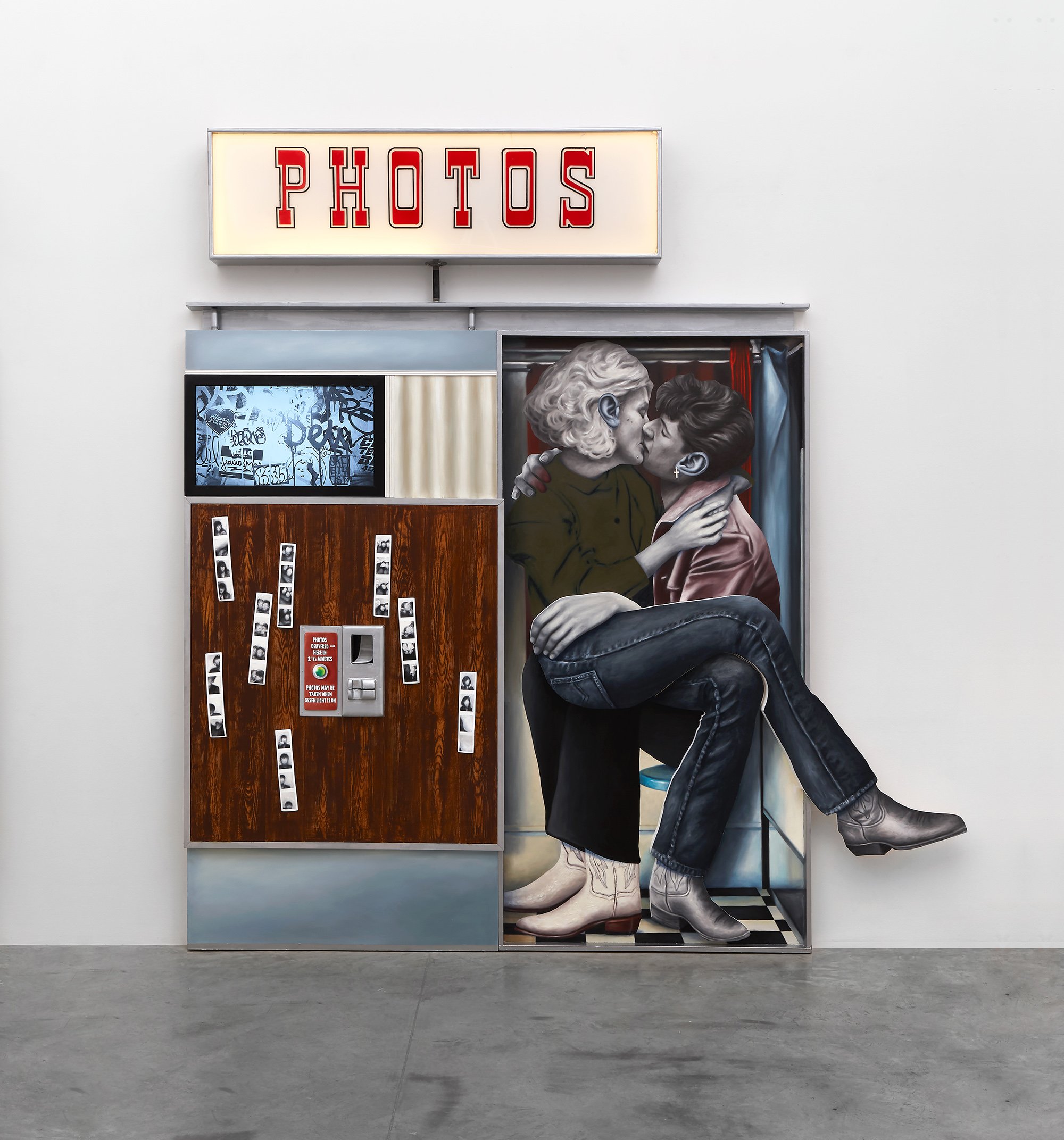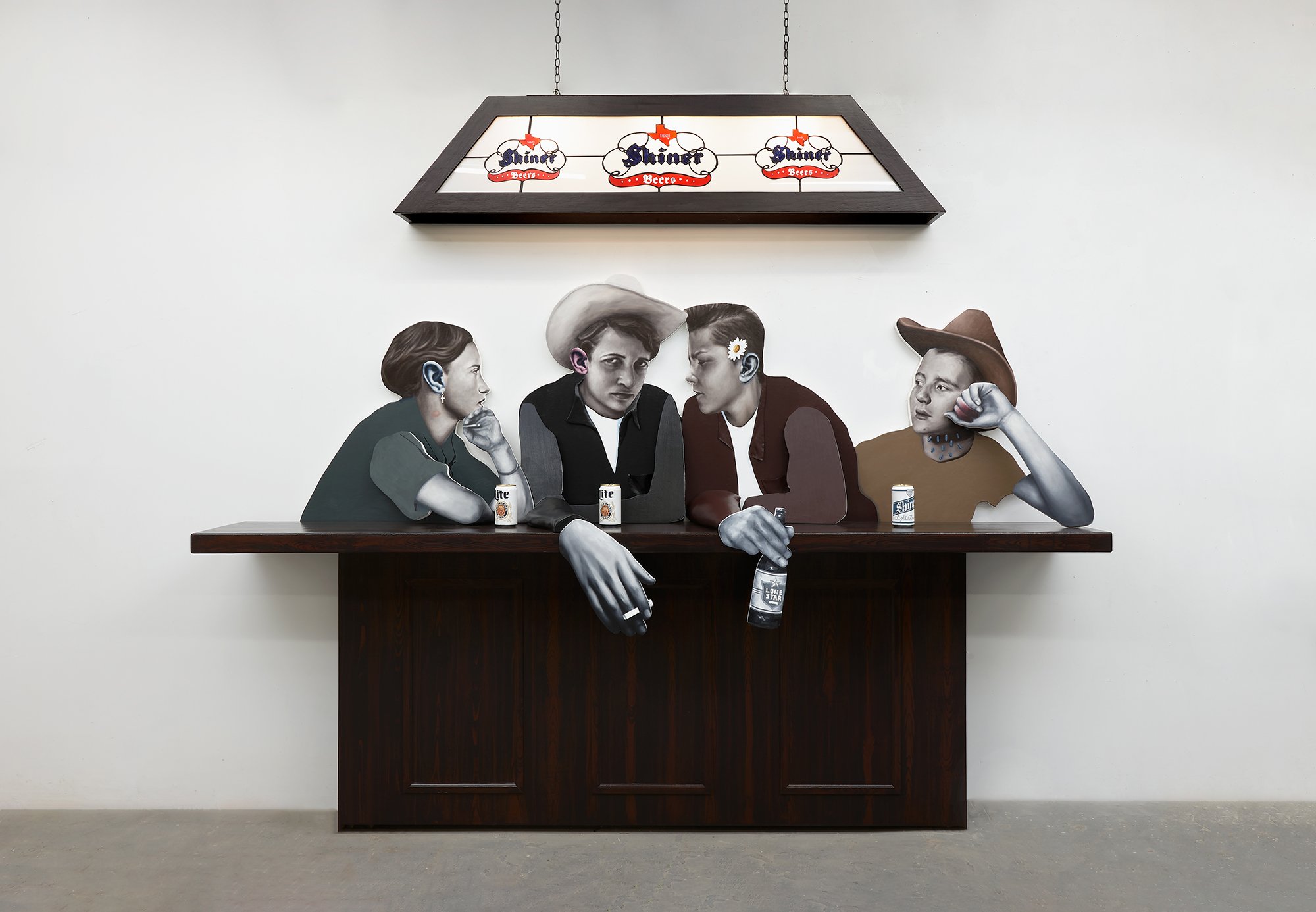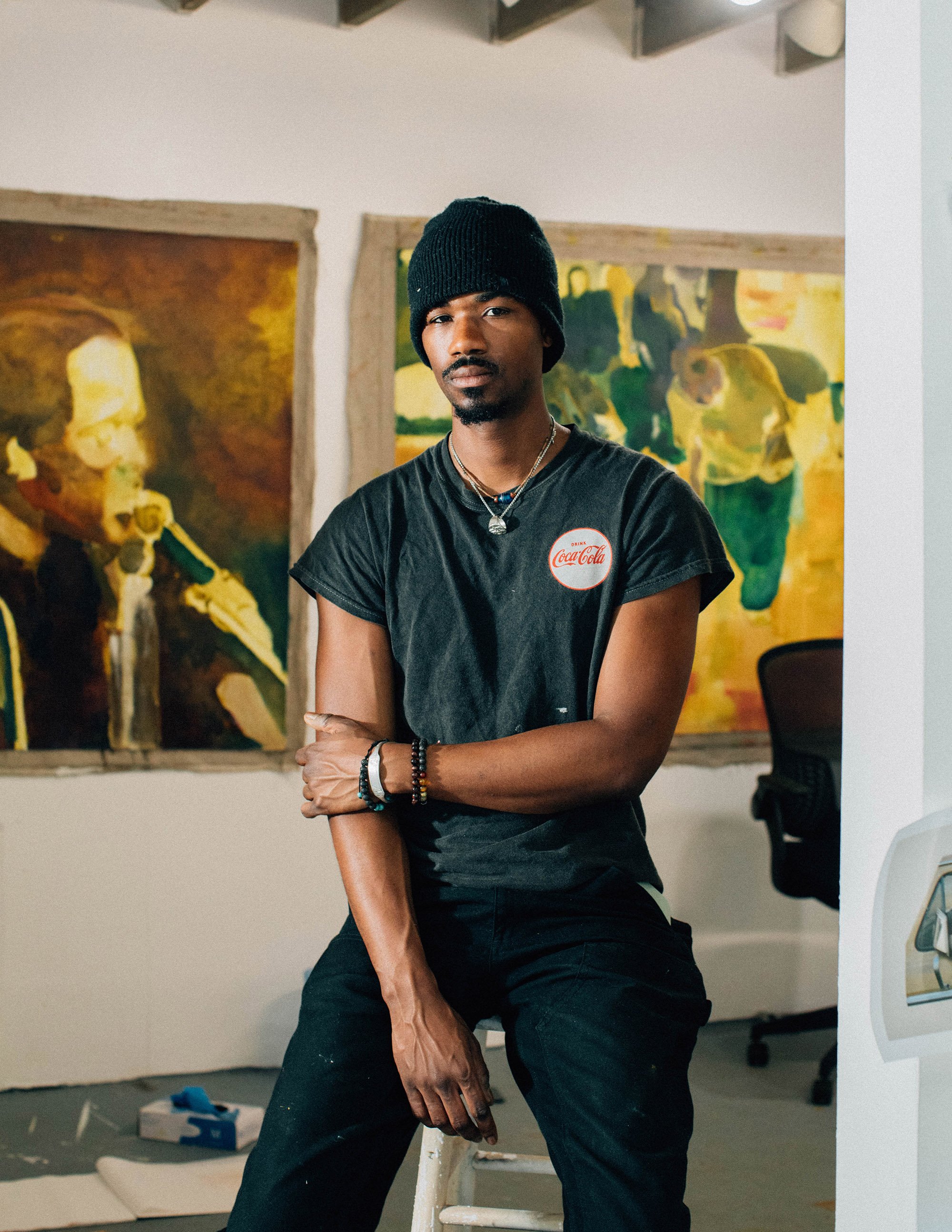
March
Chloe
Chiasson
The people in Chloe Chiasson’s paintings look like characters in old Turner Classic Movies. There’s drama in their poses and a cinematic quality in how they interact with one another and within space, whether they’re sitting on a fence, leaning against a tree, or drinking at a bar. Chiasson’s desaturated palette also gives these works the longing air of a faded photo album. Physically, they could belong on stage, like realistic backdrops in a play, as each consists of a shaped panel, constructed so the scenes are highly dimensional—in relief.
If Chiasson is playing with elements of production and fantasy, it is with the very sincere intention of building an unbounded reality she wishes to be true. For the past year and a half, she has been exploring imagery that depicts “this world of a very queered South, pulling from both a lived experience and the imagination of its alternative,” she said. With this comes “the general reconstruction of Southern space as queer space.”
Growing up in the small conservative town of Port Neches in Texas, Chiasson felt alienated because of her queer identity until she moved to New York. Large-scale and often focused on acts of intimacy of various scales, her works feel like quiet celebrations of gender fluidity and true sexual identity, but tinged with a yearning for what could have been in an ideal world. “I’m really focused on creating a world and body of work that, for the moment,” she said, “is focused on critiquing and challenging while simultaneously creating this version of a South, this version of my home, that I maybe wouldn’t have felt I had to leave.”
In Miami, she focused on a large painting of a person in a truck, their arm leaning out toward the viewer. Because the work was destined for her first institutional solo show, her vision for it did not change. But making it among other artists with their own goals and desires was its own gift: “Working alongside them reminded me why I love doing what I do,” Chiasson said, “but also the reason I am doing it.”
–Claire Voon
Chloe Chiasson’s residency was generously sponsored in part by Leslie and Michael Weissman.
Blind Spots (2022); oil, acrylic, plexiglass, resin, foam, wire, cigarette butts, and canvas on shaped panel.





Clockwise starting top left: Chiasson assembles one of her life-like, large-scale works at Fountainhead Residency, photographed by Rose Marie Cromwell. Sunday Confessions (2022), oil, acrylic, metal, wood, fiberglass, resin, paper, LEDs, plexiglass, velcro, and canvas on shaped panel with video installation. A portrait of Chiasson by Cromwell. The Renegades (2022) oil, acrylic, wood, plexiglass, resin, foam, LEDs, porcelain, chain, lipstick, aluminum, and canvas on shaped panel. The Eyes of Texas (2022) oil, foam, and canvas on shaped panel.
Devin B.
Johnson
Devin B. Johnson is a painter who is always taking snapshots. In his homebase of New York, walks fuel what he envisions on canvas; he’ll see people or a scene, take a picture, and translate that moment into his art—luminous portraits of everyday Black life that hover between figuration and abstraction. “It’s a way to give reverence and hospitality to the people that dwell in the space,” Johnson said. “The hospitality I think about is not necessarily grabbing a portrait of the person, but encapsulating an energy or sentiment.”
His idea of hospitality comes from Gayatri Chakravorty Spivak as discussed in her book Harlem, in which the scholar considers the importance of one’s intention within new spaces. “I like to think about this idea of getting to know a place before I can feel comfortable taking from it,” Johnson said. “I want to sit, mold into it, see what’s going on.”
In Miami, he focused on three paintings destined for exhibitions in Los Angeles and London. Walking along Biscayne Bay or soaking in the city’s scenery from an Uber, he continued photographing—“just taking inventory of moments I felt were beautiful,” he said—and carried those feelings into his studio. “Seeing things, feeling the vibe and energy, other associations can open up from that,” he added. “A lot of the work is depicting my body, me, in transit, and how to articulate the subconscious bits of scenes that go on in between the space that I dwell.”
His colors became warmer, more vibrant, and more lush. He also integrated water from the bay into paints, sprinkling them with ash and allowing evaporation to organically move the pigments. One painting, titled Nothing Gold Can Stay, draws on a photograph taken in Williamsburg, Brooklyn, of a man standing near a stoop. Rendered in intense reds and oranges, it invites entry into a prolonged moment of quiet solitude, but one seemingly on the precipice of interruption. “Things are always in ebb and flow,” Johnson said. “I love to think about how I can capture the flux of reality and its different parts.”
–Claire Voon
Devin B. Johnson’s residency was generously sponsored in part by Leslie and Michael Weissman.
Serenade (2022); oil and spray paint on linen.





From left: Devin B. Johnson completes a work in progress at Fountainhead Residency, photographed by Rose Marie Cromwell. Gates #2 (2022); blunt ash and spray paint on paper. One Flew the Coop (2022); oil and spray paint on linen. A portrait of Johnson by Cromwell. Look Down (2022); oil and spray paint on linen.
Jenny
Feal
Jenny Feal arrived in Miami without any art or materials—“just two hands,” she said, “and energy.” For the Havana-born, Lyon-based artist, visiting Florida was to be in a place of familiarity, where the weather, smells, and Spanish language summoned her back to her homeland of Cuba. She thus turned to her surroundings as a source material, taking walks and returning to the residency with all sorts of objects: plants, shoes, coconuts.
Using her favored mark-making elements of clay and water, she drew each item to scale, the resulting images wispy, reddish copies of reality. “It was not really about a topic but about form or color or maybe a way to have a joke between them,” Feal said of her studies. “I started to think about the history of the objects, which we cannot find in Europe—I have no more of this nature in my life now.” Such notions of loss and absence are core to her work, which is rooted in her Cuban identity and often responds to histories of migration and displacement. Feal is used to working on a much larger scale, however: she typically builds installations out of wicker, earthenware, wood, and other natural materials that together evoke a strange isolation, as if one arrived on the heels of another’s departure, and in their relocation of terrestrial matter recast habitual landscapes as sites of possibility.
Focusing on materials sourced from the Floridian environment allowed Feal to think more deeply about objects as vessels and metaphors, and all the meanings they can embody across time and geographic boundaries. Significantly, devoting her month to drawing also marked a valuable return to working on paper. “It was a break for me to take my time and discover new forms,” she said. “It was therapy.”
–Claire Voon
Jenny Feal’s residency was generously sponsored in part by Leslie and Michael Weissman.
Pienso que tus versos son flores que llenan tierras y tierras
I think your verses are flowers that fill lands and lands)
(2019); wood, straw, jute, mud, water and glass.





Clockwise from left: Pienso que tus versos son flores que llenan tierras y tierras (I think your verses are flowers that fill lands and lands), 2019; wood, straw, jute, mud, water and glass. A portrait of Feal by Rose Marie Cromwell. Detail of In the shade and with hats (2020); glass. Feal arrived to Fountainhead Residency with few materials or pre-determined plans for how her work would take shape, and her studio practice there involved collecting items from the natural environment. In the shade and with hats (2021); glass, fabric, wall painting, clay, stainless steel tanks.



